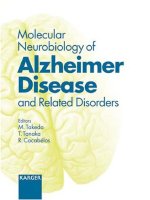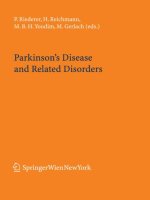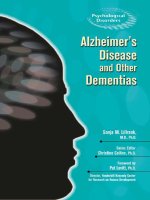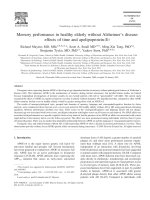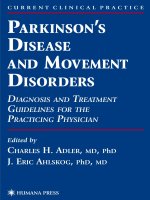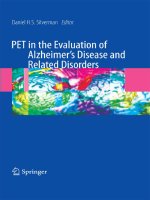PET in the Evaluation of Alzheimer’s Disease and Related Disorders docx
Bạn đang xem bản rút gọn của tài liệu. Xem và tải ngay bản đầy đủ của tài liệu tại đây (3.86 MB, 231 trang )
PET in the Evaluation of Alzheimer’s Disease
and Related DisordersDaniel H.S. Silverman
Editor
PET in the Evaluation
of Alzheimer’s Disease
and Related Disorders
Editor
Daniel H.S. Silverman, M.D., Ph.D.
Head, Neuronuclear Imaging Section
Associate Chief, Division of Biological Imaging
Associate Professor, Department of Molecular and Medical Pharmacology
Associate Director, UCLA Alzheimer’s Disease Center Imaging Core
David Geffen School of Medicine
University of California
Los Angeles, CA
USA
ISBN 978-0-387-76419-1 e-ISBN 978-0-387-76420-7
DOI 10.1007/978-0-387-76420-7
Library of Congress Control Number: 2008940848
© Springer Science + Business Media, LLC 2009
All rights reserved. This work may not be translated or copied in whole or in part without the written
permission of the publisher (Springer Science + Business Media, LLC, 233 Spring Street, New York,
NY 10013, USA), except for brief excerpts in connection with reviews or scholarly analysis. Use in
connection with any form of information storage and retrieval, electronic adaptation, computer software,
or by similar or dissimilar methodology now known or hereafter developed is forbidden.
The use in this publication of trade names, trademarks, service marks, and similar terms, even if they are not
identified as such, is not to be taken as an expression of opinion as to whether or not they are subject to
proprietary rights.
Printed on acid-free paper
springer.com
Among all the clinical indications for which radiologists, nuclear medicine physi-
cians, neurologists, neurosurgeons, psychiatrists (and others examining disorders of
the brain) order and read brain PET scans, demand is greatest for those pertaining
to dementia and related disorders. This demand is driven by the sheer prevalence of
those conditions, coupled with the fact that the differential diagnosis for causes of
cognitive impairment is wide and often difficult to distinguish clinically.
The conceptual framework by which evaluation and management of dementia is
guided has evolved considerably during the last decade. Although we still are far
from having ideal tests or dramatic cures for any of the established causes of
dementia, our options have expanded with respect to both the diagnostic and thera-
peutic tools now available. In the first chapter of this book, the contribution and
limitations of different elements of the clinical examination for diagnosis of cogni-
tive symptoms are described, and the roles of structural and functional neuroimag-
ing in the clinical workup are given context.
The clinical utility of brain positron emission tomography (PET), as with other
imaging modalities, depends in part on how accurately and fully the information
inherently represented in the scans is appreciated and relayed in the interpretation
of the images. Even highly trained imaging specialists are challenged by this
since, for example, neuroradiologists are generally far more familiar with com-
puted tomography (CT) and magnetic resonance (MR) studies of the brain than
with PET studies, and specialists in PET and PET/CT facilities tend to be much
more experienced with oncology studies than with dedicated brain studies per-
formed for the evaluation of neurologic disorders. To help meet this challenge,
the second chapter offers practical instruction on adopting a systematic method
for visual analysis of scans, describes how quantification with clinically available
and friendly software tools can be employed to assist with analysis, and then
illustrates a straightforward approach for integrating the qualitative and quantita-
tive findings in meaningful interpretations. An Atlas in the final section of this
book complements Chapter 2 by providing interpretive practice for many real
(and clinically realistic) cases, to which the tools outlined in the second chapter
can be directly applied.
The most frequent causes of dementia are neurodegenerative disorders, with
Alzheimer’s disease being the most common. By the time patients are symptomatic
Preface
v
vi Preface
with these disorders, they have undergone significant distinct alterations in brain
metabolism. The increasing use of brain PET stems from the high sensitivity of this
imaging tool in identifying those alterations. The third chapter looks at the full
spectrum of changes in glucose metabolism detectable with PET in monitoring the
course of cognitive decline, beginning before the emergence of the first neurologic
symptoms, in people who are predisposed to developing problems, in some cases
many years into the future. Progressive changes observed with PET in the brains of
patients who experience very mild symptoms, to those who meet criteria for having
mild cognitive impairment, to those suffering from full-blown dementia, are
described, as is the role of PET in the differential diagnosis of the underlying cause
for the dysfunction.
Neurodegenerative diseases often impact not only on cognitive function, but
also on motor function. The two neurologic domains can be affected in isolation,
but frequently a mixed presentation of symptoms occurs. For example, approxi-
mately one third of Alzheimer’s patients eventually experience parkinsonian
symptoms and, conversely, a similar proportion of patients with Parkinson’s dis-
ease develop significant cognitive impairment. Other conditions, such as demen-
tia with Lewy bodies, may be characterized at an early stage by both motor and
cognitive problems. Chapter 4 examines neuronuclear imaging studies explicitly
aimed at illuminating changes in the brain associated with movement disorders.
Their potential utility with respect to drug development, as well as in direct clini-
cal application, is explained.
Although the most commonly performed clinical PET studies by far are car-
ried out with [
18
F]fluorodeoxyglucose (FDG) as the imaged radiotracer, substan-
tial advances have occurred in the development of other radiotracers with which
to probe brain processes associated with neurodegenerative disease. Chapter 5
describes work that is making it possible to observe and measure the molecular
participants of such processes as they accumulate, or are lost from, living brain
tissue. In the setting of Alzheimer-related changes, one molecular participant in
particular, the β-amyloid of extracellular plaques constituting one of the histo-
pathologic hallmarks of Alzheimer’s disease, has attracted substantial attention
in both industry and academic scientific settings. Following the introduction of
this area of investigation in the fifth chapter, Chapter 6 is devoted to expanding
on the scientific implications and clinical potential of radiotracers being devel-
oped to localize and measure β-amyloid deposits occurring in the brain. In the
latter chapter, particular attention is given to characterizing β-amyloid deposi-
tion in older people who would not be considered cognitively impaired by stan-
dard clinical criteria.
PET scans, particularly with FDG, have demonstrated diagnostic and prognostic
utility in evaluating patients with cognitive impairment and in distinguishing
among primary neurodegenerative disorders and other etiologies for cognitive
decline. Since the diagnostic capabilities of this medical technology have outpaced
therapeutic advances, a look into the future of PET requires concomitant consider-
ation of the future of therapeutic strategies for addressing the underlying condi-
tions. As preventive and specific disease-modifying treatments are developed, early
Preface vii
detection of accurately diagnosed neuropathologic processes, facilitated by
appropriate use of PET and other neuroimaging technologies, can be expected to
increasingly impact on the enormous human toll currently exacted by these
disorders.
Daniel H.S. Silverman, M.D., Ph.D.
work, moving it from the realm of abstract ideas into its present reality. I would like
to thank Rob Albano who, representing the publisher (at a time when Springer was
still Springer-Verlag), was present from its inception and first invited me to con-
sider a project along these lines. I felt fairly sure at the time that taking on this
project was a bad move, but he managed not to let me talk him (or myself) out of
it prematurely. I also wish to thank developmental editor Margaret Burns who,
working with me from almost the earliest days of the project, managed to stay
perfectly poised on the fine line between helpful prodding to keep the project mov-
ing forward and patient understanding when that forward motion may have seemed
imperceptible to an external observer (particularly as obstacles to our originally
anticipated timeline arose and had to be creatively overcome). Thanks are also due
to Springer’s book production manager Frank Ganz, and associate editor Katherine
Cacace, for ably guiding this project through the final stretch and across the finish
line. I am indebted to all of my colleagues who contributed as authors and co-
authors to the final work: my friends and colleagues at UCLA, Linda Ercoli, Gary
Small, Vladimir Kepe, Henry Huang, Saty Satyamurthy, and Jorge Barrio, with
whom I have been fortunate to collaborate over the past decade on a wide range of
imaging-related projects; Lisa Mosconi, who has shared her considerable experi-
ence on changes in brain metabolism associated with the earliest stages of
Alzheimer’s disease; John Seibyl, a friend of many years who has always sportingly
accepted my invitations to participate in any number of forums of symposia and
writing projects and has once again offered his insights into the movement side of
the neurodegenerative coin, much to the benefit of this text; Bill Klunk, for readily
agreeing at the outset to take responsibility, along with Chet Mathis and colleagues
Julie Price, Steve DeKosky, Brian Lopresti, Nicholas Tsopelas, Judith Saxton, and
Robert Nebes, for their excellent contribution on amyloid imaging; my colleague
Karl Herholz, for his insights in attempting the impossible task of forecasting the
future; and Vicky Lau, Cheri Geist, and Erin Siu, who applied their trained eyes,
creative talents, and organizational skills to successfully bringing to life reams of
clinical data and images into cogent clinical cases. Finally, I wish to express my
appreciation to those who have played roles less directly related to this actual text,
but no less important to its realization: Johannes Czernin, with whom I literally
Acknowledgments
ix
x Acknowledgments
worked alongside since my first day on the Nuclear Medicine Service at UCLA,
and Mike Phelps, whose pioneering work with PET served as a major source of my
inspiration to enter the nuclear medicine field to begin with, for the nearly one and
a half decades of friendship and support they have offered personally and, in
addition, professionally in their roles heading the Ahmanson Biological Imaging
Division, and Department of Molecular and Medical Pharmacology, respectively;
and my family—my wife Wei, our kids, our parents Donna and Robert and Pei and
Robert, and my sibs Anne, Beth, and Mikhael, whose contributions of friendship,
love, understanding of my professional commitments (and over-commitment), as
well as the many more specific roles played in day-to-day life throughout the time
that this text has been in preparation (and long before), would require another book
to fully enumerate.
Part I Imaging Applications in Current Clinical Practice
1 Clinical Evaluation of Dementia and
When to Perform PET 3
Linda M. Ercoli and Gary W. Small
2 Clinical Interpretation of Brain PET Scans: Performing
Visual Assessments, Providing Quantifying Data,
and Generating Integrated Reports 33
Daniel H.S. Silverman
3 FDG PET in the Evaluation of Mild Cognitive
Impairment and Early Dementia 49
Lisa Mosconi and Daniel H.S. Silverman
4 PET and SPECT in the Evaluation of Patients with
Central Motor Disorders 67
John P. Seibyl
Part II Emerging Approaches Using PET
5 Microstructural Imaging of Neurodegenerative Changes 95
Vladimir Kepe, Sung-Cheng Huang, Gary W. Small,
Nagichettiar Satyamurthy, and Jorge R. Barrio
6 Amyloid Imaging with PET in Alzheimer’s Disease, Mild
Cognitive Impairment, and Clinically Unimpaired Subjects 119
William E. Klunk, Chester A. Mathis, Julie C. Price,
Steven T. DeKosky, Brian J. Lopresti, Nicholas D. Tsopelas,
Judith A. Saxton, and Robert D. Nebes
Contents
xi
xii Contents
Part III Atlas
7 Interpretive Practice Atlas 151
Daniel H.S. Silverman, Victoria Lau, Cheri Geist, and Erin Siu
Index 211
Contributors
Jorge R. Barrio, Ph.D.
Distinguished Professor, Department of Molecular and Medical Pharmacology,
David Geffen School of Medicine, University of California, Los Angeles, CA
Steven T. DeKosky, M.D.
Professor and Chair, Department of Neurology, University of Pittsburgh,
Pittsburgh, PA
Linda M. Ercoli, Ph.D.
Assistant Clinical Professor, Department of Psychiatry and Biobehavioral
Sciences, the Semel Institute for Neuroscience and Human Behavior and the
Resnick Neuropsychiatric Hospital at the University of California,
Los Angeles, CA
Cheri Geist, B.Sc.
Research Associate, Neuronuclear Imaging Section, Department of
Molecular and Medical Pharmacology, David Geffen School of Medicine,
University of California, Los Angeles, CA
Sung-Cheng Huang, D.Sc.
Professor, Department of Molecular and Medical Pharmacology, David Geffen
School of Medicine, University of California, Los Angeles, CA
Vladimir Kepe, Ph.D.
Associate Researcher, Department of Molecular and Medical Pharmacology,
David Geffen School of Medicine, University of California, Los Angeles, CA
William E. Klunk, M.D., Ph.D.
Professor, Department of Psychiatry, University of Pittsburgh, Pittsburgh, PA
Victoria Lau, B.Sc.
Research Associate, Neuronuclear Imaging Section, Department of
Molecular and Medical Pharmacology, David Geffen School of Medicine,
University of California, Los Angeles, CA
xiii
xiv Contributors
Brian J. Lopresti, B.S.
Research Instructor, Department of Radiology, University of Pittsburgh,
PET Facility, Pittsburgh, PA
Chester A. Mathis, Ph.D.
Professor, Department of Radiology, University of Pittsburgh, Pittsburgh, PA
Lisa Mosconi, Ph.D.
Assistant Professor, Department of Psychiatry, New York University School
of Medicine, New York, NY
Robert D. Nebes, Ph.D.
Professor, Department of Psychiatry, University of Pittsburgh Medical Center,
Pittsburgh, PA
Julie C. Price, Ph.D.
Associate Professor, Department of Radiology, University of Pittsburgh,
Pittsburgh, PA
Nagichettiar Satyamurthy, Ph.D.
Professor, Department of Molecular and Medical Pharmacology,
David Geffen School of Medicine, University of California, Los Angeles, CA
Judith A. Saxton, Ph.D.
Associate Professor, Department of Neurology, University of Pittsburgh,
Pittsburgh, PA
John P. Seibyl, M.D.
Senior Scientist, Imaging Division, Institute for Neurodegenerative Disorders,
New Haven, CT
Daniel H.S. Silverman, M.D., Ph.D.
Head, Neuronuclear Imaging Section; Associate Chief, Division of
Biological Imaging; Associate Professor, Department of Molecular and
Medical Pharmacology; Associate Director, UCLA Alzheimer’s Disease
Center Imaging Core, David Geffen School of Medicine, University of
California, Los Angeles, CA
Erin Siu, B.Sc.
Research Associate, Neuronuclear Imaging Section, Department of
Molecular and Medical Pharmacology, David Geffen School of Medicine,
University of California, Los Angeles, CA
Gary W. Small, M.D.
Professor, Parlow-Solomon Professor on Aging, Department of Psychiatry,
David Geffen School of Medicine at University of California Los Angeles,
Los Angeles, CA
Nicholas Tsopelas, M.D.
Professor, Department of Psychiatry, Western Psychiatric Institute and Clinic,
University of Pittsburgh, Pittsburgh, PA
Imaging Applications in
Current Clinical Practice
Clinical Evaluation of Dementia
and When to Perform PET
Linda M. Ercoli and Gary W. Small
The number and proportion of adults over 65 years is expected to increase rapidly
over the next several decades. According to projections from the United States
Bureau of the Census,
1
between the years 2000 and 2030, the population aged 65
and over is expected to double from 35 to over 70 million. The largest proportion
of older adults will be between the ages of 65 and 74 years, and the largest growth
is projected to occur in individuals 85 years and older, increasing from 4.3 to 8.8
million. Because age is the greatest risk factor for dementia, as the population of
elderly people increases, so will the number of patients suffering from dementia.
Given that early treatment interventions are able to keep patients at higher levels of
functioning and future innovative therapies may be able to delay the onset of
dementia and slow its progression, it is becoming increasingly important to accurately
diagnose dementia as early as possible.
This chapter outlines the basic elements of a clinical diagnostic evaluation for
Alzheimer’s disease (AD) and other dementias; and also addresses how to identify
candidates for a dementia evaluation, discusses the role of neuroimaging in a clinical
dementia evaluation, and identifies future directions.
Definition of Dementia
According to the Diagnostic and Statistical Manual of Mental Disorders, 4th
edition,
2
the essential features of dementia include impaired memory plus impair-
ment in at least one other cognitive domain (e.g., language, executive, and
visual-spatial skills), and significant disturbance of work or social functioning or
both resulting from cognitive deficits. These features cannot occur exclusively
during the course of a delirium, but delirium may occur during the course of
dementia. Dementias may also include mood changes, personality alterations,
and behavioral disturbances.
Depending on variation in presentation or whether patients present earlier versus
later during the course of a dementing disorder, distinguishing between age-related
cognitive decline and early dementia, and differentiating among different types of
D.H.S. Silverman (ed.), PET in the Evaluation of Alzheimer’s Disease and Related Disorders, 3
DOI: 10.1007/978-0-387-76420-7_1, © Springer Science + Business Media, LLC 2009
4 L.M. Ercoli and G.W. Small
dementias can be challenging. Diagnostic criteria for various dementing illnesses
have been developed to aid in differential diagnosis.
3,
4
For instance, dementia of the
Alzheimer’s type, the most prevalent form of dementia in older adults, is characterized
by a gradual onset and progression of symptoms without another identifiable or
treatable cause. A definite diagnosis of dementia of the Alzheimer’s type can be
made only by histopathologic examination of brain tissue, usually postmortem.
The National Institute of Neurological and Communicative Disorders and the
Alzheimer’s Association consensus statement
5
provide criteria and guidelines for
the diagnosis of possible and probable AD. Probable AD is similar to progressive
dementia of the Alzheimer’s type, whereas possible AD includes dementia syndromes
with atypical onset, presentation, or progression in which an additional or co-morbid
disease (e.g., tumor or cerebral thrombosis) may be implicated but not believed to
be the cause of the dementia.
Epidemiology of Dementia and Preclinical Syndromes
Dementia affects approximately 27 million people worldwide, with approximately
5 million new cases annually (one new case every 7 s).
6,7
Although younger persons
can suffer from dementia, dementias are most common in older age, and the incidence
of dementia doubles every 5 years after age 60. The most common form of dementia
is dementia of the Alzheimer’s type (or AD), which accounts for approximately
65% of dementias in late life. The prevalence of AD increases with age, afflicting
approximately 13% of Americans age 65 and older and up to 50% of those over 85
years. Currently, AD costs the Centers for Medicare and Medicaid Services and
U.S. businesses an estimated $148 billion annually.
8,
11
A number of other common forms of dementia have been identified. Vascular
dementia (VAD), is estimated to account for approximately 15–20% of dementias
12,
13
in the United States and Europe; and up to 50% of dementias in Japan.
14
Dementia
with Lewy bodies (DLB) accounts for up to 30% of dementias,
15
and frontotemporal
dementia (FTD), a spectrum of disorders that particularly affects persons under 65
years of age, accounts for approximately 5% of dementias
16
although some esti-
mates are higher.
17
Less frequent dementia syndromes include Creutzfeldt-Jakob
disease, HIV-associated dementia, neurosyphilis, Parkinson’s dementia, normal
pressure hydrocephalus, and dementias resulting from exposure to toxic substances
(e.g., alcohol, heavy metals, illicit substances), metabolic abnormalities, and
psychiatric disorders.
Preclinical dementia syndromes, characterized by milder forms of memory loss
and no functional impairment, are prevalent in the general population and have
received increasing clinical attention. Their identification is important because
early pharmacologic interventions in dementia may delay the onset and slow
the progression of AD, extend quality of life, offset medical costs, and delay placement
in care facilities.
18,
19
1 Clinical Evaluation of Dementia and When to Perform PET 5
Two common preclinical syndromes include age-associated memory impairment
(AAMI)
20
and mild cognitive impairment (MCI).
21,
22
AAMI is the mildest form of
age-related memory loss. It occurs in persons over 50 years of age and is character-
ized by self-reported memory complaints, decreased memory performances compared
with younger adults (typically defined as 1 standard deviation below young adults
on memory tests), but normal memory compared with age peers. The prevalence
of AAMI has been estimated at 40% in people 65 years of age or older, and
although most cases are benign over the short term, approximately 1% of these
individuals develop dementia each year.
20,
23
MCI typically involves a more severe
loss of memory that is still not associated with functional decline. Persons with
MCI show reductions in memory or other cognitive domains compared with age
peers. Many persons with MCI show similar cerebral pathology to persons with
AD,
24,
25
and approximately 15% of persons with MCI develop dementia annually
and most often AD.
21,
22
The outcome of MCI varies, indicating that it is a hetero-
geneous disorder. Although eventually most persons with MCI develop AD, some
develop other types of dementia, some remain stable, and others revert to normal
cognition. Originally, MCI was characterized as an amnestic disorder, but more
recently the definition has been expanded to include other cognitive (e.g., amnestic
plus other impairments; single or multiple non-memory domains) or etiologic
subtypes (e.g., vascular).
22
Obstacles to Accurate Diagnosis of Dementia
Despite better diagnostic methods and pharmacologic interventions, several obstacles
impede the diagnosis of dementia.
26,
27
Previous studies indicate that false-negative
diagnoses may occur in 50–90% of cases.
28,
29
If physicians mistakenly attribute early
cognitive decline to normal aging, evaluation and treatment may be delayed until
the disease severity and neuronal damage have progressed.
Reduced time that physicians spend with patients is another obstacle to detecting
AD. In today’s managed care environment, many primary care physicians have
limited time to conduct a comprehensive informant interview. Under such circum-
stances, helpful strategies for obtaining relevant information include enlisting the
assistance of nurses or trained staff to interview patients or family on the telephone
or at the office before seeing the physician. Questionnaires to collect information
on daily function, medications, and family history of dementia can be mailed to the
patient or family before the appointment or administered in the waiting room.
Another obstacle to diagnosing dementia is overreliance on and overinterpretation
of laboratory findings, particularly CT and MRI results. The diagnosis of dementia
usually is a clinical diagnosis. The purpose of laboratory assessment is to identify
uncommon treatable causes and common treatable co-morbid conditions.
Similarly, overreliance on typical cutoff scores on mental status or cognitive
screening tests, or using such tests for the sole purpose of diagnosis is another
obstacle to diagnosing dementia. Highly educated individuals who have suffered
6 L.M. Ercoli and G.W. Small
cognitive decline may show normal function on cognitive screening tests such as
the Mini Mental State Exam (MMSE), whereas persons with low education may
appear to have cognitive impairment or dementia when they actually have not
declined.
30
Age- and education-corrected normative data are available for some
screening tests, such as the MMSE.
31,
32
As a rule of thumb, cognitive screening
measures are most useful as a quantitative baseline against which to compare future
assessments, and not to be used alone for diagnostic purposes. When the diagnosis
is unclear, neuropsychological testing may better distinguish between normal aging
and dementia, as well as identify deficits that point to a specific diagnosis.
Finally, clinicians often have difficulty distinguishing complaints of the worried well
(i.e., normal aging) from those of patients who have an underlying brain disorder that
results in cognitive decline. Subjective complaints can indicate the presence of mood
disorders or early dementia; in any event, they should be taken seriously.
33,
34
Determining When to Conduct a Dementia Evaluation
A variety of symptoms and circumstances may warrant a dementia evaluation.
Several of the following issues are worth considering.
Patient or Family Concerns
Any patient or family concerns about cognitive decline or personality, behavioral,
or mood changes are indications for a mental status assessment and possibly a
dementia evaluation. One recent study showed that collaterals’ perceptions, particularly
persons who live with or know the patient well, are accurate in reporting a patient’s
cognitive capabilities.
35
Functional Impairment
Declines in the ability to conduct higher-level daily activities or patients stopping
or reducing the time spent in such activities should prompt a dementia evaluation.
Patients with early or mild AD suffer declines in their ability to perform higher-level
daily activities such as planning or preparing meals, managing finances or medications,
using a telephone, keeping track of appointments, and driving without getting lost.
These functional impairments may be the patient’s or family’s earliest indicators
that something is wrong. A dementia evaluation is warranted when patients have
dysfunction in higher-level activities but intact basic functions such as eating and
maintaining personal hygiene and grooming, because these basic activities often
remain normal until later stages of a dementing disease.
1 Clinical Evaluation of Dementia and When to Perform PET 7
Changes in Personality and Behavior
Significant changes in behavior and mood often occur in early dementia.
36
For
instance, patients with AD may demonstrate personality changes, irritability, anxiety,
apathy, or depression early in the disease process, followed by delusions, hallucinations,
aggression, disinhibition, and wandering in middle and late stages. Such behaviors
are the most troubling to caregivers, make home management difficult, and frequently
lead to family distress and nursing home placement.
37
Delirium
Delirium is a syndrome of acquired impairment of attention, alertness, and perception
2
that can be the consequence of a general medical condition, such as infection,
pharmacologic toxicity, or metabolic disturbance. Delirium is often confused with
dementia because both are characterized by global cognitive impairment; however,
delirium can be distinguished from dementia by its acute onset, marked fluctuations
in cognitive impairment over the course of a day, disruptions in consciousness and
attention, and alterations in the sleep cycle. Hallucinations and visual illusions are
common. Further complicating the picture, delirium and dementia often co-exist,
particularly in a hospital setting; and dementia, a risk factor for delirium, contributes
to the higher prevalence of delirium in the elderly.
38,
39
Thus, patients with persistent
cognitive deficits, even after delirium clears, should undergo a dementia evaluation.
Abrupt Changes in Cognitive, Emotional, or Neurologic Status
Patient presentations or family complaints of an abrupt onset of mood disturbance
or change, behavioral changes, changes in sleep/wake cycles, or abrupt cognitive
decline should prompt a mental status examination.
Depression
A thorough evaluation should be conducted if patients have gradual or abrupt onset
of depression. The distinction between depression and dementia in late life is not
always clear, because depression and dementia may be co-morbid, depression may
be a prodrome to dementia, or the two may be mistaken for each other, as both
involve memory difficulties.
40,
41
Noting the level of awareness of cognitive
difficulties may be helpful in distinguishing dementia from depression. Demented
patients may be aware of cognitive deficits, but they may underestimate their severity
8 L.M. Ercoli and G.W. Small
and impact on everyday functioning accurately,
42
whereas depressed patients tend
to exaggerate memory or cognitive problems. Neuropsychological evaluations also
can be helpful in differentiating depression from early dementia.
43,
44
Some depressed
geriatric patients have a reversible dementia syndrome, but such patients require
continued monitoring, as nearly 50% develop irreversible dementia within 5 years.
45
The Basic Dementia Workup
According to most consensus guideline recommendations, the elements of a basic
dementia workup include a detailed history, physical and neurologic examinations,
basic laboratory tests, and a computed tomography (CT) or magnetic resonance
imaging (MRI) scan of the brain.
46
Additional tests—such as diagnostic and laboratory
tests, functional neuroimaging and neuropsychological evaluations, speech and
speech/language assessment, and genetic testing—are obtained as necessary, pending
results of the basic workup.
If time is limited, before meeting with the patient, the physician can send forms
and questionnaires for the patient or a collateral to complete to expedite information
gathering about the present complaint, current medications and supplements, and
family history of dementia. In addition, standardized and validated forms to assess
cognitive complaints (e.g., Memory Functioning Questionnaire),
47
and functional
activities (e.g., Pfeiffer Functional Activities Questionnaire)
48
also may be included
in the packet. Given that patients with cognitive difficulties may not be able to
provide accurate information regarding their history, a person who knows the patient
well can complete the forms.
During the intake evaluation, the physician conducts the initial history to obtain
information about the chief complaint; background information on the onset,
course, and progression of deficits or functional impairment; medical and psychiatric
history; relevant social history; and to observe patient behavior and assess mood.
The physician also conducts a neuropsychiatric screen to formulate diagnostic
hypotheses. The initial interview also can serve to establish rapport and a working
relationship with the patient.
Chief Complaint and History
The clinician gathers additional information about the patient’s chief complaint and
medical background. The history includes data about the onset (e.g., abrupt versus
insidious and gradual), nature of symptoms, course of the current problems (i.e.,
fluctuating or progressive), and whether the patient has experienced changes in
personality, mood, or daily functioning. It is important to try to construct a timeline
of what has changed for the patient and when; therefore, the physician should try
to distinguish longstanding difficulties from those of recent onset.
1 Clinical Evaluation of Dementia and When to Perform PET 9
Memory complaints correlate with depression, other psychiatric illnesses, declining
physical health, objectively measured memory impairment, or incident dementia,
33,
34
and declines in cerebral metabolism.
49
In some persons, memory complaints may be a
symptom of an early dementing disorder, especially in persons with cognitive impair-
ment
50
or highly educated persons, who may notice changes before detection with
objective tests.
33
Medical/Psychiatric/Surgical Histories and Review of Systems
Gathering information about previous episodes of memory loss, mood or other
psychiatric disorders, and medical conditions and procedures are pertinent to under-
standing the patient’s current presentation. The physician obtains history on basic medical
conditions, especially those that may affect cognition, including hypertension, cardio-
vascular disease, diabetes, head injury with loss of consciousness, sleep apnea, and
seizures. Many physical conditions such as cardiac, pulmonary, and kidney dysfunction,
toxic or metabolic (e.g., diabetes, thyroid dysfunction) abnormalities, vitamin deficien-
cies, recent infections including urinary tract infections, seizures, and HIV risk factors
can impair mental abilities. Elderly individuals are vulnerable to vascular complications
following cerebral hypoperfusion, and the clinician should inquire about related risks,
such as congestive heart failure and coronary artery bypass graft or other surgeries
under general anesthesia.
51
Substance Use and Dependence
An accurate history of substance use should include a nonjudgmental inquiry about
the amount of alcohol and other substances used, length of use, periods of sobriety,
and impact of use on relationships and functioning. Information about substance
use is critical because substance abuse or dependence is associated with cognitive
difficulties. Recovery of cognitive abilities may be slow in elderly alcohol-abstinent
individuals.
52
Smoking history is important, because smoking is a risk factor for
cerebrovascular disease.
Medications and Allergies
Review of both prescription and over-the-counter medications is warranted, particularly
because some medications, medication interactions, or medication mismanagement
may result in or contribute to cognitive dysfunction. Patients with memory difficulties
may not properly self-administer medications; therefore, the physician should
inquire how patients keep track of medication use (i.e., use of pill organizers) and

